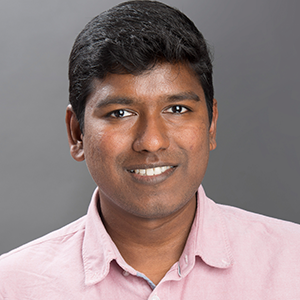Glycotyping as a novel approach to study leukemia stem cell heterogeneity and function

Sriram Sundaravel
PhDAlbert Einstein College of Medicine
Project Term: July 1, 2024 - June 30, 2026
Leukemia stem cells (LSCs) are highly heterogeneous populations and key contributors to AML progression. Here, I aim to employ heparan sulfate (HS) glycotyping to resolve LSC heterogeneity. Using complementary genetic and antibody-based approaches, I will delineate the functional roles of HS pathway during AML progression. The newer insights provided by these studies could potentially uncover novel LSC therapies and facilitate diverse training for me to become an independent leukemia researcher.
The overarching goal of my research is to understand the intricate mechanisms of how acute myeloid leukemia (AML) progresses and identify potential new avenues for treatment. Despite notable advancements in the overall survival rates of AML patients in recent times, approximately 85% of individuals still face disease relapse and eventual mortality. AML fundamentally represents disorders of blood stem cells, marked by an impediment in stem cell differentiation, leading to inefficient blood production in the bone marrow. In our quest to conquer AML, we're faced with a challenging adversary–leukemia stem cells (LSCs). These cells are highly diverse at the genetic and molecular levels, making them tricky to target with standard treatments. To effectively combat AML and achieve lasting remissions in patients, we must target and eliminate leukemia stem cells (LSCs). Importantly, current methods reliant on cell surface proteins fall short in capturing the full functional heterogeneity of LSC subtypes. Even advanced techniques like single-cell sequencing have limitations, as they're often too destructive to study live LSCs. This is where our innovative approach comes in. We're looking at a unique aspect of these cells called heparan sulfate (HS) glycotypes, which are essentially the molecular signatures of sugars on their surfaces. HS are linear sugar chains exhibiting intricate structural modification patterns. These patterns arise from nearly limitless combinatorial possibilities of modifications, adding an additional layer of information to the cell surface. Using a library of specialized antibodies recognizing distinct HS structures, I aim to create distinct profiles, or "glycotypes," of LSCs. Early findings indicate significant variations in these glycotypes of LSCs during AML progression. Preliminary results also suggest that these glycotypes might not just be variations but could have functional significance. By understanding these molecular differences, we might uncover new ways to classify and target LSCs. I’m particularly interested in exploring whether tweaking a cellular pathway related to sugars could be a potential therapeutic strategy. This work is a blend of discovery science and potential translational application, taking us one step closer to developing treatments that specifically target the roots of AML. This research could not only contribute to our understanding of AML but also set the stage for a new era in personalized leukemia therapies.